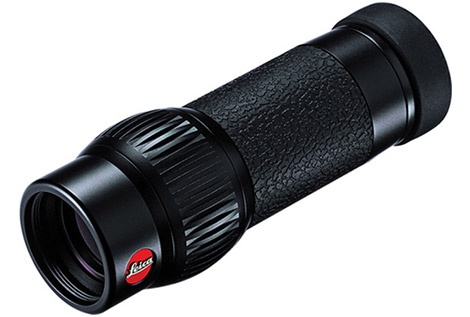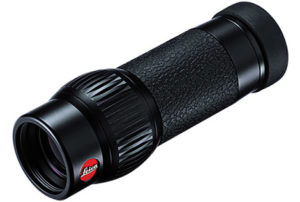One of the best aspects of cultivating a passion in any of the activities classifiable under the general category of natural history is that one is never bored. Irrespective of wherever you may be – from mountain meadow to shopping mall parking lot – there is almost certainly some item of the natural world that calls out (sometimes even literally) to be examined more closely and pondered.
Because of this, many of us try to carry a hand lens and a compact binocular or monocular along with us as we go about our daily activities. Yet however small they may be, compact binoculars of a suitable quality for serious observation are still often larger than might be desirable to carry absolutely everywhere and, sadly, due to a less-than-healthy market demand, good monoculars are getting increasingly more difficult to find. Fortunately as to the latter, a few firms are taking somewhat of a contrarian position to the overall optics market and still developing new monoculars; the most recent example of which being Leica with their Monovid 8x20mm.
Built upon the optical design of the Leica Ultravid 8x20mm binocular, the Monovid 8x20mm offers users an image at least every bit as razor sharp and vibrant as its binocular cousin but in a chassis that it less than half the size. If fact, although Leica includes a beautifully designed leather case with each Monovid, the optic itself is truly small enough to be carried in a shirt pocket. But don’t let the small size fool you; the Monovid bears no resemblance, either in terms of design or operation, to some of the other “pocket-sized” monoculars that have been previously seen in the marketplace and which have given monoculars the bad reputation they have in the past too often deserved.
In terms of function, by including a fully padded pull-out eyepiece, the user can comfortably position and hold the optic in front of the eye and achieve a full field of view with or without eyeglasses. The grooved rubber focus dial is positioned near the objective end and in front of the main grip area in order to allow either one or two handed use. Furthermore, as it encircles the entire chassis of the optic, the diameter of this dial is large enough to allow a greater rotational distance in relation to the amount of correction observed, thus giving the user more refined control while focusing the instrument.
Of course, the best structural design in the world won’t make any optic worth carrying if it lacks the optical performance needed to accomplish the tasks for which it is intended. Fortunately, just as it has been by many of the other fine optical instruments produced throughout the firm’s long and distinguished history, Leica’s reputation for optical excellence is well represented by the Monovid. A phase corrected roof prism assembly and a lens system treated with Leica’s own High Durable Coating (HDC™) combine to ensure that the image seen through the Monovid is far beyond what might be reasonably expected from an optic of its size. Moreover, Leica’s application of their AquaDura coating to the external lens surfaces helps keep them clear and easy-to-use even in the rain. Needless to note, the Monovid is completely sealed and Nitrogen-filled to protect it against internal fogging.
By this point, it more or less goes without saying that the image provided to the user by the Monovid is no less than superb. Bright, clear, and possessing exceptional true-to-life color, the optic even seems to outperform its Ultravid binocular cousin in a side-by-side assessment – something for which a reason cannot be discerned from the published specifications yet which nevertheless can clearly be observed. And if that wasn’t enough, the Monovid’s objective lens is threaded to accept a small macro lens that is included with the instrument by which the already close 5.9 foot (1.8 meter) minimum focus distance can be shortened to a remarkable 11.8 inches (30cm), making the Monovid not only suitable for field observation but useable as a field macroscope as well.
Having lived with a Monovid of my own for a good few years now, and having carried it on trips ranging in rigor and duration from a jaunt to the local grocery store to an extended journey into the rain forests of Central America, I can in all honesty state that the Leica Monovid 8×20 is indeed one of the most innovative, useful, and praise-worthy field optics to have been introduced in many years. For all those who never again wish to find themselves without an optic at hand when an interesting bird, moth, plant, rock formation or most anything else that piques the curiosity is noticed, the Monovid is truly a must-have instrument.
As previously noted, the Leica Monovid 8x20mm is packaged with the macro lens, a custom leather “fast-draw” belt case (with a handy threaded holder for the macro lens on the interior surface of the case’s lid), an eyepiece cover, and an adjustable wrist strap with twin connectors – one for the Monovid and one for the eyepiece cover to prevent it’s being mislaid or lost during use. The chassis and all the accessories of the original Monovid are classic black; however for those who desire a little more visual panache in the exterior design of their optics, a special red-trimmed as well as a silverline edition have also recently been made available.
Magnification: 8x
Objective lens diameter: 20 mm
Exit pupil: 2.5 mm
Field of view (angular): 6.3°
Field of View (linear) : 110 m at 1,000 m
Eye relief: 15 mm
Close focusing distance: 1.8 m
Close focusing distance with close focus lens in place: 30 cm
Watertight to a depth of 5.0 m /16.5 ft
Length: 3.7 in. (98 mm)
Weight: 3.6 oz. (112.0 g)
(Portions of this article were originally published in Bird Watcher’s Digest.)



February 11, 2017 @ 13:34
Thanks for the great article! I have had my Monovid for only a short time but already appreciate it’s elegance and quality. However, I do wish that Leica provided a protective cover for the objective lens.
Thanks again!!!
September 5, 2017 @ 05:19
Ottimo monocolo, non sto li a ripetere ciò che è già stato scritto, come qualita di immagine è un rasoio.